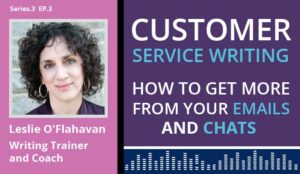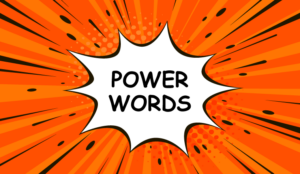The Contact Centre Podcast: Series 3 Episode 3
In this episode, Leslie O’Flahavan discusses some of the most common mistakes that we make in customer service writing and how to avoid them.

In our conversation, we also talk about personalizing emails and chats, the danger of imposing “word bans” in the contact centre, and interesting activities to improve our customer service writing.
To listen to the podcast directly from this web page, just hit the play button below:
The Contact Centre Podcast – Episode 15:
Customer Service Writing: How To Get More From Your Emails And Chats
This podcast was made possible by our sponsor, Genesys.
Podcast Time Stamps
- 2:10 – Bad Examples of Customer Service Writing
- 6:37 – Banning Certain Words and Phrases
- 9:20 – The “Any Inconvenience” Fiasco
- 12:03 – Personalizing Emails and Chats
- 15:04 – Using “Transition Words”
- 17:31 – Training Exercises to Improve Writing Skills
- 21:22 – More Ugly Customer Service Language
- 26:09 – Email and Chat Templates
Here is a Transcript to the Podcast
Charlie Mitchell: As a writer, I imagine there have been many occasions where you’ve read a customer service live chat or email and that’s really made you cringe. When was the last time and what was the last chat or email that you’ve read that really had this effect on you?
Leslie O’Flavahan: Well, how many hours do you have? I have lots of answers to this question, but from the get-go, from the very start here, I want to say that while I have read many, many emails and chats with customers that made me cringe, that made me weep, that made me despair, I have also read an equal number that impressed me, encouraged me, and made me feel very hopeful about future communication.
I definitely take the glass is more than half-full approach to writing to customers. I think some companies are doing it very, very well. Now having said that, let’s talk about some alarming communications I’ve seen via email and chat.
One comes to mind, and of course this is not a human error, but it began Dear First Name, Last Name. That was really embarrassing, and it really leads to the type of human error, a similar type of human error. I often see emails that go to customers where the prompt for the advisor, for the customer service agent, to customize the template, that they’ve ignored the prompt.
That’s really embarrassing and it’s really negligent. If the template says “paraphrase the customer’s complaint here”, and we send the email out saying, “paraphrase the customer’s complaint here”, that’s terrible. Or sometimes I see emails that are really bad because the attempt to paraphrase the customer’s complaint has no energy in it whatsoever. Instead of saying “thank you for contacting us about the problem you had trying to open the packaging of your new battery storage”, they’ll say, “thank you for contacting us about the problem you have” – that’s really poor quality writing.
Charlie: Yeah, I’ve definitely seen a lot of examples like that and I’m sure it’s something that we will definitely come onto, but as you were speaking there, I was thinking of other examples that I’ve seen as well, and there’ve been letters, or especially emails actually, that I’ve read where it’s included long sentences of three or four lines with multiple ideas within each individual sentence. I would maybe recommend sticking to one idea per sentence and keeping sentences to a two-line maximum. Do you think that’s solid advice or it’s a case-by-case scenario?
Leslie: I love the first part of what you said and I don’t love the second part of it. The first part of keeping a sentence to a single idea, that’s really good advice and durable and reliable advice. But the idea that we know the length of a line, I think comes to a real misunderstanding, truth. And that is we can’t tell what size device our customers are reading our correspondence on, and the range of sizes from desktop, which is rare, of course, to laptop, which is somewhat common, to tablet, to phones of so many different sizes. The idea of the line is a metaphor; we don’t really know.
I think what I take away from your idea is more, please write concisely, please understand that shorter sentences are easier to read than longer ones. Please keep your sentences to one idea. And in chat, of course, I think it’s fine to write the chats with the idea that there will be a lot of back and forth. Namely, it’s okay to write a concise or a short statement when you’re chatting with the customer knowing that there may be quite a few engagements, because chat is built that way and that’s a good thing in chat where it’s not such a good thing in email.
Charlie: Yeah. I think there’s a lot of good advice there that contact centres are handing down to advisors, but I think also there is advice that we give to advisors when they’re writing chats and emails that might not particularly be so great. And one of those was a contact centre that I heard of recently banning certain words and phrases. What are your thoughts on language bans like this?
Leslie: I think unless it’s a swear word, we shouldn’t really ban it, because a ban on a particular word is a loss of decision-making for the customer service agent, and we want customer service agents to make good decisions in writing. If, for example, we made the foolish choice to ban the word “thanks” and insist on the word “thank you”, which some contact centres do. I think it’s ignorant, but they do it. Then we have now banned the customer service agent from matching the tone of the customer in chat, for example. Let’s say it’s a casual customer and he’s, the customer himself, is writing, “Hey, how’s your day going?” If we say to the customer service agent, you must use a formal phrase like “thank you” and you may not use “thanks”, now we have prevented the customer service agent from exercising an important writing skill.
Leslie: And what I find is that when we ban individual words, we’re not actually banning the word itself, we’re banning a particular attitude, and I think it’s okay to ban an attitude, but it’s not practical to ban a word.
And here’s an example. Some of my clients really dislike the phrasing “no problem”, and they ban it. They don’t want their chat agents to respond, “no problem” when the customer requests, for example, the waiver of a fee. What they want is them to say, “I will be glad to waive this fee. It’s easy for me to do. I’ll be glad to do it and I have done it.” That’s what they want them to say. So they don’t want to imply that the customer’s request to have the fee waived is a problem. So they say, never say “no problem.” But really, if the second thing you say after “no problem” is, “I would be glad to waive that fee for you” then really is “no problem” a problem? I don’t think so. I would rather hire well for customer service writing and trust the customer service agents than ban individual words.
Charlie: I do think that a lot of this also has to do with the training, as you say, and training good alternatives as well as just banning words. Otherwise, advisors are having to think for a long time of what they can say instead and that in turn will increase contact durations and it would delay the messages between customers and advisors, which surely won’t have a great impact on customer satisfaction as well. And I want to go back to the example that you gave there of “no problem”. I was thinking, do you have any other phrases that you dislike hearing and if so, what would you recommend advisors use instead?
Leslie: Well, I deeply dislike hearing “We regret any inconvenience this may cause” because if you look in the dictionary under passive aggressive, that phrase is the leading phrase. I deeply, deeply dislike that phrase, but I dislike it for reasons that require thinking, not mere obedience.
I don’t want to hear “we regret any inconvenience” because the customer has been inconvenienced and “any” is suspicious. Right? And this may have caused… well the customer just told you it caused inconvenience. Drop the “may”, it’s not a “may” issue any more. It did cause inconvenience. But I return to my other point. If we ban that phrase, “we regret any inconvenience this may have caused”, then we have to help customer service agents find and use more sincere language when they apologize, and sincere apologies take responsibility. And lots of times companies are reluctant to take responsibility for the customer’s unhappiness and that’s why we have such passive-aggressive phrasing as “we regret any inconvenience this may have caused”.
Charlie: Yeah. I’m sure there’s lots of examples that we could both say together, but one tip that I recently heard for avoiding that passive writing, as you were saying, was to at the end of the sentences that you write to put the words “by robots” at the end of them. And if that sentence makes sense with the words “by robots” at the end, it’s a passive sentence. So an example I would give for that is “mistakes were made” and then if you put “by robots”, that mistake doesn’t then make sense. However, if you would say, “I’m sorry for the mistake by robots”, that wouldn’t make sense. So that’s a good active sentence. I think that’s a nice example there for knowing whether you are writing in an active manner or a passive manner.
And I think, just to go on as well and add to that example, you said, it’s “I’m sorry for any inconvenience”, at least for me, they’re saying “I’m sorry”, instead of “apologies”, as I find that to be a very impersonal way of saying I’m sorry. It’s a way of distancing yourself from the apology, when you want a customer service advisor to take ownership of the customer’s problem instead. And I think that’s a very key point. And I think personalization through writing is a very interesting topic. And I was just wondering what tips you had for better personalizing a live chat message or an email?
Leslie: Well, I have a tip I can offer broadly and then some specific methods of acting on this tip. The best tip for personalizing a response to a customer is to view their own email as worthy of being mined for personal details and to be prepared to use the personal details in the response. So I would coach customer service agents to look at the email for the details the person has offered in addition to their level of anger or frustration or their account number, and use those details in the response. So sometimes customers mention where they were online when they were trying to get the job done. “I was logged into your app.” In your response you would use that information, “When you were logged into our app.” “I’m sorry to learn how much frustration you experienced when you were logged into our app.”
Or if they’re purchasing something, they might mention the occasion. For a wedding gift, for my brother-in-law, they might mention the recipient. So you use that information. Lots of customers when they’re upset mention the length of their history with your company. So they might say, “I have been shopping with you since before you had an eCommerce option,” or “I have been a loyal flyer with your airline for the last seven years, since you opened an airport in such and such city.” So the more we can exploit the information customers have given us, the more sincere our emails will sound, and our chats as well. And in this day and age, when we exploit the information and reuse the information customers have shared with us, we go a great distance to convincing them it’s a human responding to them, not a bot. Because right now when customers receive somewhat anonymous responses that didn’t take into account the information they themselves have shared, it’s natural for them to wonder whether they’re getting a response that’s human or automated. We can prove our responses are human if we use more of the information they’ve shared with us.
Charlie: It’s almost as if you’re using those traditional human qualities to differentiate yourself, and I think more and more brands will look when they can’t compete with certain other brands in terms of customer journey efficiency. If you use customer service as a differentiator and to have really good soft skills within your emails and chats and really good personalization. That can be such a key way of ensuring customer loyalty.
I think it’s something that we often take for granted within the customer service industry, and I just want to now talk about some other writing tips that we’ve actually talked about before. And I remember as we speak that we’ve previously talked about using transition words was in writing such as, however, therefore and furthermore and how that might not be best practice. Why might this not be the case?
Leslie: We need those transition words when we’re writing in live chat because those transition words do in fact knit together a discussion: therefore suggests cause and effect. However suggests contrast.
So we need them when we’re writing live chat but in substantive or multi-paragraph customer service emails, which we are really wondering whether our readers will read, our customers will read thoroughly. I think it’s more modern to use headings or titles on the sections of the email than it is to use transition words or phrases like we used to do when we were writing academic papers in high school and college, because email is the least modern of all of the written customer service channels and it often is the longest.
Leslie: And so we must acknowledge that customers are scanning our emails hoping to get to the section of the email that answers their most top priority question. Headings enable them to scan more efficiently than transition words do. Transition words between paragraphs suggests that the writer believes the reader will read all the paragraphs in the order they’re presented. And that’s just not true. That’s not how people read customer service emails. So titles or headings are better at signalling the topic of a paragraph in an email than a transition word.
Charlie: Yeah, I think that’s a very key point and I think headings and bullet points can work to the same effect as well. If you want to list something instead of putting that in a big paragraph, bullet pointing those steps instead can be a great way. And I know on an email as well – you can do this on letters as well – but I think it would work in an email to put a P.S. for a really key point because I think whenever I see P.S. on an email, my eye is immediately drawn to that. And that can be a great way to highlight any key points that you need to give. But moving on now to actually training advisors to become really good customer service writers. Do you know of any fun exercises to make this training more engaging for advisors?
Leslie: Well, I think all the training techniques I use are fun, but maybe not.
Leslie: Actually I do want to just push back a little bit against the notion of fun and playfulness in training. Of course it should be fun. Of course playfulness is appropriate, but there’s a stronger theme throughout our whole discussion and that is people who communicate in writing with customers deserve substantive, meaningful, frequent, and authentic training. Yes, yes, yes. It should be fun. This is a given. We’re not going to ankle lock anyone to a desk and bore them for hour upon hour. Yes, it should be fun, but mostly it should be authentic. Meaning the training allows them to exercise the writing skills they need with their particular customers. I’ve given the example of explaining why you will or why you won’t give a fee waiver. Well, if your work doesn’t include giving fee waivers, then don’t ever have a training that includes that module. It’s immaterial to your work.
I think the most fun and the most authentic customer service writing training activities include the chance to (1) review samples of your organization’s own communication with customers. Trainers and managers owe it to the people who they’re training to gather examples of real communication with customers. That’s the first thing. That will make it fun. There’s often a lot of fear, “Oh I don’t want to expose anybody.” “Oh, this could be embarrassing.” That’s the wrong fear. The bigger fear should be “Oh, my training is irrelevant.” So the training should always include people’s real employees’ own communication with customers. And I would say choose good examples, not bad examples.
The second coaching technique that I think is really fun and is also really authentic is to encourage customer service agents to communicate in the role of customer secret-shopper-style communication with comparable companies. And when I do onsite writing trainings, for example, when I do live chat, I will always budget about 45 minutes or so for the customer service agents to go chat with another company and bring a transcript back to class so we can discuss it.
Because it’s possible to chat with your competitors. They don’t know, and that’s really interesting. You can see people who do the same job as you do coping with some of the same struggles you have. And I encourage them during training, Hey, act like a sceptical customer and put the agent through the paces, or act like a really, really friendly customer who doesn’t stay on topic for the customer service concern but is really friendly or notice what the wait time feels like. The three ugliest words in customer service chat are “are you there?” And see what it feels like to wait during a customer service chat. Fun? Yes, mm hmm sure, fun. But mostly authentic and mostly built upon real samples of real work.
Charlie: Yeah, I think that there’s some really great advice there. I really liked the idea of setting aside that time with advisors to go through competitors. Because even if it shows them, oh we’re doing a better job anyway, that’s a nice little competence boost for the advisors as well. And I think it was really interesting that you said the ugliest words in customer service are “are you there?” And that was particularly key.
But there’s also something that we’ve discussed before about the phrase “please don’t hesitate to contact us”, which is another particularly ugly phrase for customer service. Do you want to explain a little bit about why this phrase might not be best to use in your emails and live chats?
Leslie: Well sure. I mean it’s sweet. The person who writes “please don’t hesitate to contact us if you have any questions”, this is kind of sweet. The person who writes it means it in a good way. But the funny thing is, customers never hesitate to contact us. That’s not a thing.
Charlie: Yes.
Leslie: I would modernize it and I would say, “please contact us at any time” or “please contact us ”and put the hours of operation. And then I would continue this sentence to list some areas where the customer might contact us. What I’ve experienced is if your invitation for further contact is narrow, it does not exclude questions outside that invitation.
I’ll give you an example. I’ve been using the example where the customer’s asked for a waiver of a fee. Let’s say it’s a banking customer asking the bank to waive a late fee. So at the end of that communication we might write, “Please contact us Monday through Friday, 9:00 AM to 7:00 PM if you have any questions about fees or any other issue”, because if you invite the contact on a particular topic such as the one we’ve just answered, that’s another way of showing the customer, Hey, I really am noticing what matters to you. I’m quite sure that if the customer, that banking customer has a question about a car loan, the invitation to contact them about fees won’t exclude a question about a car loan. It’s just a more genuine invitation for further contact.
Charlie: I think it’s a really funny image of somebody, I think you’ve shown it on our presentation of yours, but somebody just sat staring outside of a window, just somebody pretending to hesitate to contact a customer service team.
I think it’s something that’s very funny, but I think there’s definitely some great advice there. And the more we talk about these phrases, the more that are coming to my mind. And there was another one as well, which was the phrase “your feedback will be shared with the appropriate department”, which is one that again is very cringe-worthy for me. Do you also have maybe an issue with this sentence?
Leslie: Yes. I’m actually laughing. So you know I have an issue with it. I’m going to tease that, I’m just going to mock that phrasing, but it’s actually a bad idea for an important reason. If we’re going to share the feedback with the appropriate department, that implies there might be an inappropriate department and if there is an inappropriate department, I would like to be the director of the inappropriate department.
But so often when customers contact us, we cannot solve their problem. We may not be able to answer their question or we cannot change a policy to give them what we want. And the only thing we have to offer is the certainty that we are going to let someone in our company know how the customer felt. That’s all we have to offer. And if we use phrasing like, “Please be assured we will share your feedback with the appropriate department,” we are wasting the only thing we have to offer. So the most important change we should make right there is to name the department. Customers aren’t really believing us that we’re sharing the feedback anyway, but if we name the department it’s a little bit better. So we could say, “Please be assured that we will share your feedback about the meal you were served on our airline with our catering department.” Share the feedback about X with the department and then mention the department by name.
Charlie: I think giving those specific examples are really important and I think that’s great advice for contact centres out there, if they have these templates in place to take out the phrase “I’m sorry for any inconvenience.” To take out the phrase “Please don’t hesitate to contact us.” To take out the phrase “Your feedback will be shared with the appropriate department.” I think if you have templates with these phrases on, I think once you listen to this, I’m hoping they’ll be coming off. I think actually, Leslie, that leads us to another interesting topic that actually you mentioned in your first point and that was around templates, and some bad template mistakes that you’ve seen. What are your general thoughts on using templates in customer service emails and chats, specifically emails?
Leslie: I believe templates are completely acceptable in emails and in chats as long as the templates are well-written and written to enable customization, not to make customization hard. That’s one condition. And secondly, that agents are trained and supported for the work it takes to customize a template. And in fact, as a lifelong writing teacher, I know it’s more difficult, it requires higher-level writing skills to customize a template than it does to free text a response from beginning to end, because when we ask our customer service agents to insert freshly written phrases and words into pre-written content, that’s actually very difficult. Too often contact centre managers think that’s a really easy and mechanical skill. And in certain cases it is. If you simply customize to include the customer’s first name and the account number, that’s easy. Really my dog could probably do that, but we’re talking about a substantial customization.
So the template would include an open-ended prompt and the advisor, the customer service agent, would have to actually write something there. So if you use templates, they should include open-ended prompts, which might say “paraphrase the customer’s complaint”, or they might say, “summarize what you know about the customer’s purchase history”, these kinds of things. That requires some real writing. So say yes to templates, but also say yes to writing and storing templates that are prepared for customization, and say yes to training agents. This is a hard, a difficult writing skill and they will need support with it.
Charlie: Yeah, I think that’s a particularly nice point to end on, Leslie. There’s so much that we’ve discussed there, and I’m sure the more we talk, the more typical customer service phrases and things like that will come to my mind. I think it is a very good place to stop there. But one last question before we go is where can our listeners go to hear more from you? Maybe on social media or something like that?
Leslie: Well, I hope your listeners will connect with me in lots of different ways. You can always email me and, believe me, I do not spend a lot of time scrutinizing the emails I receive. I’m just really happy to hear from people.
Charlie: That’s all for this episode. Thank you to Leslie O’Flavahan for joining us today.
Author: Robyn Coppell
Published On: 3rd Feb 2020 - Last modified: 26th Sep 2025
Read more about - Podcasts, Charlie Mitchell, Email, Genesys, Leslie O'Flahavan, Live Chat, Podcast



















